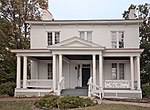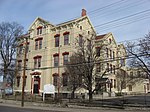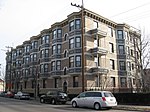C. H. Burroughs House
1888 establishments in OhioAC with 0 elementsAfrican-American women's organizationsClubhouses in OhioFormer houses in Ohio ... and 9 more
History of women in OhioHouses completed in 1888Houses in CincinnatiHouses on the National Register of Historic Places in OhioNational Register of Historic Places in CincinnatiQueen Anne architecture in OhioRomanesque Revival architecture in OhioSamuel Hannaford and Sons Thematic ResourcesWomen's clubs in the United States

The C.H. Burroughs House is a historic former house in Cincinnati, Ohio, United States. Constructed at the end of the nineteenth century by one of the city's most prominent architects, the house has been converted into a social club, but it retains enough of its integrity to qualify for designation as a historic site.
Excerpt from the Wikipedia article C. H. Burroughs House (License: CC BY-SA 3.0, Authors, Images).C. H. Burroughs House
Chapel Street, Cincinnati Walnut Hills
Geographical coordinates (GPS) Address Nearby Places Show on map
Geographical coordinates (GPS)
| Latitude | Longitude |
|---|---|
| N 39.131111111111 ° | E -84.4875 ° |
Address
Chapel Street 963
45206 Cincinnati, Walnut Hills
Ohio, United States
Open on Google Maps







